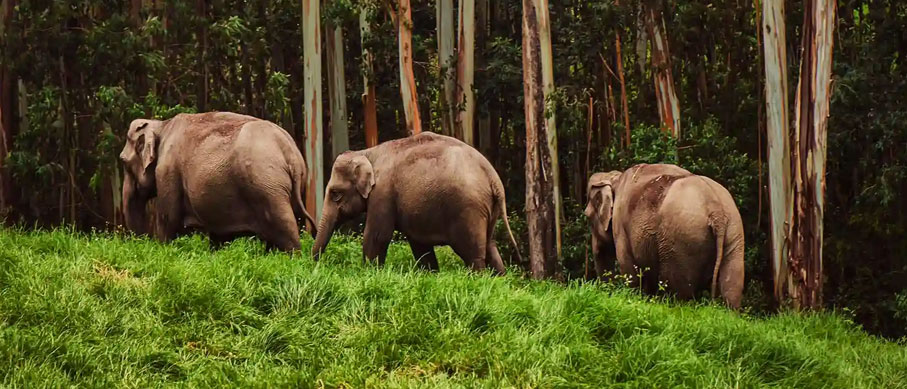Learn Interesting Facts about the Indian Elephants at Periyar
By JAGAT : [07/June/24] The Indian Elephant, a recognized sub-species of the Asian Elephant, shares its lineage with the Sumatran and Sri Lankan Elephants. Despite its gigantic appearance, it is known for its gentle nature. Asian Elephants are distinct from their African counterparts in several ways: they are smaller, have smaller ears, and possess a more rounded back, with the crown of their head being the highest point. Unlike African elephants, which have a two-fingered trunk tip, the Indian Elephant has a single-fingered trunk tip, and the males have thicker, more curved tusks. Since 1986, the Indian Elephant has been listed as Endangered on the IUCN Red List, with the wild population decreasing by at least 50% since the 1930s and 1940s, equivalent to three elephant generations.
In order to get a real experience about the interesting facts of the Indian Elephants, visiting Periyar National Park is a good option. Indian Elephants are among the popular fauna of the national park. By spending a day at the Elephant Camp, Kumily, you will get to know these innocent jumbos very closely.

Gather Information about the Indian Elephants before Visiting Periyar National Park
Appearance : Asian elephants typically stand between 6.5 and 9.8 feet tall and weigh between 2.3 and 5 tons. While generally grey, they develop lighter patches on their foreheads and trunks as they age, a change influenced by their habitat and diet. Their legs, adapted to support their massive bodies, are uniquely structured with long, solid bones that lack cavities, unlike the angular legs of other mammals. This anatomical feature allows them to stand for long periods and travel extensive distances.
Behaviour : These massive animals can spend up to 19 hours a day feeding, consuming approximately 150 kg of plant material daily. Elephants are considered ecosystem engineers due to their ability to clear large areas of vegetation, thereby creating new habitats and promoting plant growth. They follow traditional feeding routes and prefer a mix of grasslands and forests, where they forage for grasses, bamboo, legumes, bark, climbers, and palms. Elephants defecate 16 to 18 times a day, producing up to 220 pounds of dung over an area of 125 square miles. This dung disperses seeds and nutrients, aiding in ecosystem health. Elephants need to be close to water sources for daily drinking, and when they are near farmed areas, they might consume crops like bananas, sugarcane, and rice.
Lifestyle : Indian elephants are active both day and night and are known for their intelligence and complex social structures. They form matriarchal units, typically composed of around 20 related females, which can occasionally split into smaller, temporary groups. Communication between these groups occurs through low-frequency vocalizations that can be heard over long distances. Some males also join these groups. Unlike territorial animals, Indian elephants migrate seasonally, but this behavior has been disrupted by agricultural development and other human activities. Similar to many large mammals, Indian elephants tolerate cold better than heat. During the hottest parts of the day, they seek shade and regulate their body temperature by flapping their ears at varying speeds to release heat.
Habitat : Indian elephants are generalist species, thriving in a diverse range of habitats including grasslands, tropical rainforests, semi-evergreen forests, moist deciduous forests, dry thorn forests, and both cultivated and secondary forests.
Breeding and Reproduction : Indian elephants follow a polygynous mating system and breed throughout the year. Males often engage in aggressive fights before mating, which can lead to serious injuries or even death. The victorious male joins a group of females, driving away rival males. The breeding pair stays together for approximately three weeks. With a gestation period of about 22 months, the calves spend significant time with their mothers, receiving all their nutrition from the mother's milk initially. By 4 to 6 months old, they start supplementing their diet with grasses and leaves. The female elephants in the herd collectively care for the young, who are often seen playing with other calves and exploring their surroundings.
